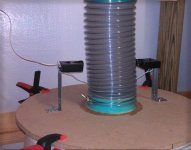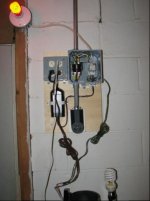Steve,
I'll chime in here too since I was the manufacturer all of the Bin Sensors shown in the pictures posted by Rushton and JSBrow. Some of these show an older version of the Genie garage door sensors that were used several years ago (the rectangular ones), but they all operate the same. The sensors are aligned directly toward one another through the flexible duct atop the dust bin so their Red and Green LEDs burn steadily to show that they are aligned. The electronics in the control box have a built-in delay so that intermittent blockage will not trip the alarm -- they need 10-12 seconds of blockage to force an alarm condition. As the bin fills, dust tends to accumulate in a conical shape in the drum and very little dust will be re-entrained into the air flowing back into the blower inlet toward the top of the cyclone. The lower 12 - 18 inches of the cyclone is mostly dead air space where the dust falls by gravity and most of the higher velocity air moves into the inlet above the lower cone. As a result, the bin sensor will sound the alarm before very much dust every gets into the air flow headed to the filters. I recommend that you do follow the guidance to interconnect the bin sensor to the CV Electrical box H230B contactor so the shut down will be automated.
One important comment -- be sure that you plug the small Bin Sensor power supply into a wall outlet that is not on a circuit connected to any motor devices such as a lathe or drill press as it may cause the power supply to fail. Further, I recommend that you plug it into a switched outlet where it is not powered when you leave the shop -- setting one up on your shop lighting circuit is ideal, but you can also add an outlet with a switch that allows to to shut the 120 Volt power off.
Over 5 years, I had 375 bin sensor customer (2011-2016) and none of them ever reported that their filters filled with dust because the alarm did not trigger. Although I have retired from making them, I am happy to answer any questions for ClearVue customers that have a bin sensor.






